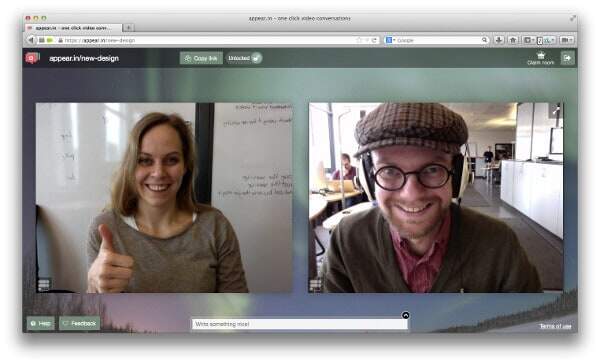Free video calling service backed by a Telco
 appear.in is one of the free and simple video chat services out there today. The story behind it is very interesting – especially as this is a home-grown solution of Telenor – not the most expected move of a Telco.
appear.in is one of the free and simple video chat services out there today. The story behind it is very interesting – especially as this is a home-grown solution of Telenor – not the most expected move of a Telco.
I asked Svein Willassen, head of appear.in, Telenor Digital a few questions about their service.
What is appear.in all about?
appear.in is a simple web based system for video conversations. The service is based on the concept of rooms, corresponding to the content of the url. Anyone that goes to a specific url will then appear together with audio and video and text chat. So for example if you go to appear.in/example you go to the room “example” and anyone else that go to that same room will see and hear you and you will see and hear them. This works without any registration, login and you don’t have to download and install an application to get it to work.
Our vision is to make it easier to meet and talk to each other on the Internet. We want video conversations on the Internet to be as easy as going over to someone and talk to them.

How does that fit into the context of Telenor Digital?
Telenor Digital has been set up to work with new Internet Services. We are working both with services that integrate with the telecommunication network operated by Telenor business units as well as services that work standalone. appear.in falls in the latter category.
In a recent press release, Telenor Digital announced collaboration with Mozilla on improving WebRTC. Can you elaborate about this a bit more?
We at Telenor Digital believe that WebRTC is the communication technology of the future. Therefore, we would like to build strong competency on this technology. We are already doing this by running a popular service based on WebRTC (appear.in). We also see that it is desirable to have strong knowledge deeper into the WebRTC stack. We think the best way to do this is to work on an actual WebRTC implementation. The idea with the collaboration with Mozilla is to make this happen. Engineers in Telenor Digital will work on the core implementation of WebRTC in Firefox. The knowledge and experience gained from this collaboration will be a great asset for appear.in as well as other projects in Telenor Digital working on WebRTC.
What excites you about working in WebRTC?
WebRTC removes the big hurdles in realizing real time communication. It has opened up a vast space of new possibilities for applications of video and audio. The possibilities are endless and we have just begun to explore what is possible. I think the world of electronic communication will look very different 5-10 years ahead from what it looks like today and WebRTC will be a core part of the transformation. I find it very exciting to take active part in this transformation.
What signaling have you decided to integrate on top of WebRTC?
We are currently using our own homegrown signaling protocol based on WebSockets. This method have served the purpose for us so far.
Backend. What technologies and architecture are you using there?
We rely heavily on the technologies provided by Amazon Web Services. These allow us to deploy a worldwide scalable TURN server infrastructure relatively easily. We are currently operating our signaling server on node.js and use database backend provided to us by AWS.
You launched an iOS app for your service. Can you tell me a bit about the porting and development challenges you faced there?
We chose to build a native iOS app using the WebRTC library for iOS. We started with this in January 2014, at which point there were several problems with the real time communication realized by the library. We chose however to ignore the problems with the library and focus on building the application around it. This turned out to be a lucky choice, because by the time we were ready with the application (around April), the maintainers of the library had fixed most of the problems.
A core issue with developing a video application for a mobile platform is the limited processing and battery capacity. These are fundamental issues that are currently hard to address from an application standpoint. We need to get hardware enabled encoding support on mobile devices and access to it from the WebRTC library. Fortunately, with the developments in the codec debate, we seem to be moving in that direction.
What was the adoption of the iOS app like?
Our current application is mostly used by people who are also using the Web application who are on the move. It is currently much less used than the web application. We are looking into how we can tailor the application better to the needs people have when on the move.
Where do you see WebRTC going in 2-5 years?
In the short term (1 year), I hope we can settle the codec question and get support in the other major browsers. (Safari and IE) This will be important hurdles for WebRTC to clear to become a dominant communication technology.
In the longer term I believe we will see a proliferation of different apps and services using voice and especially video in new, innovative and often unexpected ways. WebRTC is what will power it.
If you had one piece of advice for those thinking of adopting WebRTC, what would it be?
Look for frameworks or third party services that can get you started quickly. There’s a lot of work associated with getting a WebRTC service to run smoothly on your own. You might not want to do it yourself.
Given the opportunity, what would you change in WebRTC?
The standardization process perhaps. As it is now, it seems that too many parties have to agree to get something accomplished. This might stop the progress.
What’s next for appear.in?
We have been working for some time on some new features that we will release very soon. This includes the ability to have a contact list and to invite people from that list to a room. You can invite anyone, also people who have not used appear.in before. They will then get a link to the room you are in sent over email or sms and will be able to join you in the room with a single click.
We are rolling out these features gradually right now.
–
The interviews are intended to give different viewpoints than my own – you can read more WebRTC interviews.
